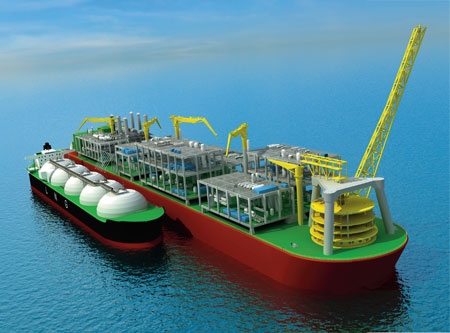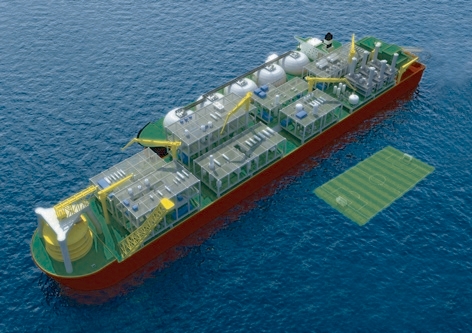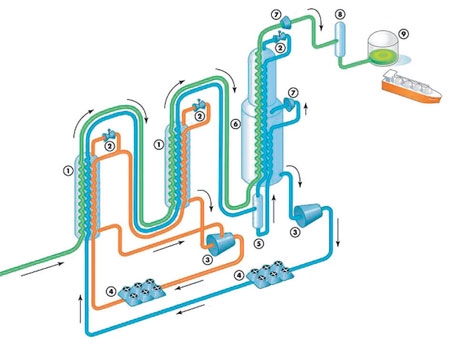A new type of vessel will soon be seen on the high seas. It will dwarf the largest aircraft carrier; even the biggest container ships will look like motor launches alongside it. Floating liquefied natural gas (FLNG) facilities will be so big that they’ll put pretty much every man-made structure barring the very largest super skyscrapers into the shade.

Currently in the planning stages, the vessels are Shell’s latest tool for one of the oil and gas industry’s most pressing problems: extracting the increasingly prized and scarce fossil fuel. It’s a big project in every sense: in terms of the technology, the investment, and the sheer scale of the FLNG vessel itself. But then, it’s a big issue, and one that the hydrocarbon industry can’t ignore.
Fossil fuels are running out; it’s a truism that’s become a cliché. But the common perception of oil wells running dry and existing facilities trying to eke out a last wisp of gas don’t quite reflect the real situation. The truth is, there’s still a vast amount of fossil hydrocarbons knocking about that hasn’t been tapped at all. The problem is, it is in very inconvenient places.
Previously, it’s been considered too expensive to try to extract these problem reserves. It would require careful diplomacy for politically unstable areas; different approaches to production for environmentally sensitive regions; and new technology for unexploited types of hydrocarbon or unusual geologies. But with the easy-to-reach reserves now dwindling, oil companies are having to investigate these options. In the technology sphere, some of the new systems are truly staggering.
’Sometimes, the gas field is just too far offshore to make it practical to build a pipeline, Sometimes there are deep ocean trenches between the field and the shore, which can’t be bridged; there are also other types of feature we can’t cross and would be too expensive to avoid.’
Wouter Meiring, Shell
While all types of fossil fuel have difficult-to-dislodge applications, natural gas is one of the most important because of its use in electricity generation. By far the lowest-emissions way to make electricity from fossil hydrocarbon, natural gas is in increasing demand; it requires less pre-treatment than oil or coal, and produces less carbon dioxide (CO2) to be released to the atmosphere or dealt with by carbon-capture processes.
However, there are many more natural gas reserves than have currently been exploited, according to Wouter Meiring, manager for liquefied natural gas (LNG) development at Shell. The problem is that natural gas is best transported in its liquefied form, as its volume shrinks by 600 times when it is condensed, but it is mainly comprised of methane and has to be chilled to -162°C to convert it to liquid. To do this requires very large plants and insulated storage, which previously has only been available on land. This means that the gas extracted from subsea reserves has to be brought ashore, and that, in turn, means it has to be pumped through pipelines.
’Sometimes, the gas field is just too far offshore to make it practical to build a pipeline,’ Meiring said. ’Sometimes there are deep ocean trenches between the field and the shore, which can’t be bridged; there are also other types of feature we can’t cross and would be too expensive to avoid.’

FLNG vessels are the Anglo-Dutch company’s answer to this question. The company has formed a consortium with gas technology specialist Technip and Korean shipyard owner Samsung Heavy Industries to design and build vessels, and has now completed a generic design. Detailed engineering studies have now begun for the first vessel Shell operates a ’design one, build many’ policy for large capital equipment and construction is expected to begin later this year. The agreement with Technip and Samsung will run for 15 years, although Shell will not be drawn on how many units it intends to build. It is also not issuing figures on the size of the investment although, when announcing the project, Simon Brinded, the company’s director of upstream development activities, indicated that it was similar to other LNG investments, at some $3bn-3.5bn (£2.2bn) per million tonnes of LNG per year, giving a total of around $10-12bn for each vessel.
The concept is simple: package all the facilities needed to extract and process natural gas the drilling rig, post-treatment, refrigeration plant needed for liquefaction, storage and the equipment for loading the LNG onto carriers to transport them to their markets onto a single vessel, take it out to the gas field and anchor it on top.
Vast vessel
Shell’s Prelude FLNG terminal in figures
- Length: 488m
- Breadth: 74m
- Height (mooring tower): 105m
- Topsides weight: 50,000 tonnes
- Fully laden weight: 600,000 tonnes
- Storage capacity: (LNG) 220,000m3 (LPG) 90,000m³ (Condensate) 126,000m³
- Cooling water pumping capacity: 50,000m³ per hour
But that simplicity is deceptive because the size of the vessel needed to achieve this task is staggering. The FLNG facility that Shell is planning will be heavier than six of the world’s largest aircraft carriers, with a fully laden weight of 600,000 tonnes; it will contain 260,000 tonnes of steel, and its deck area will be longer than four football pitches.
Other comparative statistics are equally hyperbolic. The capacity of the on-board storage tanks is equivalent to 175 Olympic swimming pools; stood on end, the vessel would be taller than Kuala Lumpur’s Petronas Towers; and the annual production of LNG alone (the vessel will also produce natural gas condensate, a mixture of low-density hydrocarbons, and liquefied petroleum gas, which is mostly butane) would meet 90 per cent of the total annual energy demand of electricity-hungry Hong Kong. Even the mooring turret part of the system that keeps the massive vessel in place will be 105m high.
The vessel will have a crew of 120, producing 5.3 million tonnes per year of hydrocarbon liquids. Of these, 3.6 million tonnes per year will be LNG, 0.4 million tonnes per year LPG, and 1.3 million tonnes per year condensates.
But despite its size, the facility is actually a miniatured plant, Meiring said. ’It’s much smaller than an onshore LNG treatment plant about a quarter of the size. Part of the reason for this is that a conventional plant needs to have a large refrigeration facility with large amounts of coolant, but part of our coolant system uses water from deep under the sea, and of course we don’t have to store that. Also, the coolant plant itself is located on the deck of the ship, with the storage tanks underneath.’
The cooling system uses a mixture of refrigerants or a system based on expansion of nitrogen gas, and can be tailored to suit the climate where the vessel is located by changing the mixture of coolants in the refrigeration plant. Trials have taken place at Shell’s combined oil and gas plant Sakhalin II in Russia, where temperatures can drop as low as -45°C and the cold ambient conditions are used to pre-cool the gas before it is liquefied. Using this natural form of auxiliary cooling both reduces the energy needed for liquefaction and, in the case of the FLNG vessels, reduces the need for extra refrigeration equipment on board.

Much modelling and testing of the concept has already taken place. Technip’s marine architects have collaborated with piping, process and equipment engineers, as well as equipment suppliers and installation specialists, to work on the problem of designing the topside equipment to handle the movement that would be experienced by the vessel in a heavy sea. Tests were carried out on a 1:60 scale model in a wave tank to design the mooring system and the offloading system with another vessel alongside, while wind tunnel tests were used to derive the loads on the vessel from the wind and ocean currents.
The design team has also been considering the hazards on board, including the high congestion on the deck, the risk of dropped objects and ship collisions, and the risks of fire and explosion and exposure to cryogenic liquids.
The size of the vessel is a result of all the duties it has to do, Meiring said. ’We simply couldn’t get all the storage we need for an economic vessel to meet the demand, along with accommodation for the crew and everything else, into anything smaller.’
FLNG is, at least in part, a development of the hydrocarbon industry’s established floating production, storage and offloading (FPSO) vessel technology, Meiring explained. This uses floating structures sometimes converted tankers, although more often purpose built to process and store oil before it can be offloaded by tankers. These have been in use since the mid-1970s, and they have proven so useful that Shell has been working on extending the concept to natural gas production for more than 10 years.
The offloading facilities on board the vessel would be similar to those of an FPSO, Meiring said, although the production equipment would be different, as would the heavily insulated storage tanks needed to keep the LNG at its low temperature. The need to operate cryogenically is a major factor in driving the technology on this project.

1 Pre-cool heat exchanger
2 Valve
3 Compressor
4 Seawater-cooled condensor/aircooler
5 Mixed
refrigerant separator
6 Main cryogenic heat
exchanger
7 Liquid expander
8 Nitrogen removal
9 LNG storage tank
Despite appearances, the FLNG facility is not a ship. It has three thrusters, each generating 6,700hp, which will be used to keep it in position over the gas field; it will be able to pivot freely around its mooring point, where it will be held in place by 24 cables running through the mooring tower. However, it doesn’t have main engines and will have to be towed by tugs to its station. ’It doesn’t need to move around once it’s there, because the idea is that it stays in place for the entire life of the gas field,’ Meiring said. This could be up to 25 years, depending on the size of the field. ’One of the big advantages of this system is that the vessel could then be stationed elsewhere at another gas field.’
It could also be used for gas fields that are too small to make a permanent rig and pipeline an economic option, he added. ’There are lots of relatively small pockets of gas around the world, and until now it just hasn’t been possible to exploit them because of the huge amount of infrastructure and investment you need.’ With an FLNG vessel, the infrastructure can be sent to the location.
The first vessel is being built to exploit Shell’s Prelude gas field, which is 200km off Australia’s northwest coast, with another planned for the Sunrise field, between Australia and East Timor. Australia has large, but previously largely inaccessible, natural gas reserves, and the need for it is pressing. China’s demand for imported gas is expected to grow fivefold in the next decade, reaching some 45 million tonnes by 2020, and the aftermath of the tsunami in Japan, with the closure of several nuclear reactors, is also likely to lead to a substantial increase in demand.
The Prelude region is susceptible to extreme weather, including cyclones. Because of this, the FLNG facility is designed to be able to withstand a force five hurricane with wind speeds more than 155mph (250km/hr). Its sheer size keeps it stable.
’This is something we’re really excited about,’ Meiring said. ’It has the potential to completely change the way that we produce natural gas. A decision to use an FLNG vessel would depend on a number of factors, with the distance to shore probably being the most important,’ he added, ’but it would give us the freedom to operate in more places than we can currently reach.’




Glasgow trial explores AR cues for autonomous road safety
They've ploughed into a few vulnerable road users in the past. Making that less likely will make it spectacularly easy to stop the traffic for...